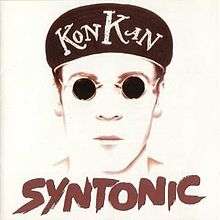
Syntonic (album)
Syntonic is the second album by Canadian synthpop group Kon Kan, released in 1990 by Atlantic Records. Syntonic was the first Kon Kan album to solely feature Barry Harris; Kevin Wynne had departed the previous year.
Two singles were released from the album: "Liberty!" and "(Could've Said) I Told You So", the latter featuring a recreation of Jimmy Soul's 1963 number one hit, "If You Wanna Be Happy".
"Time" features a recreation of Canadian band Trooper's "We're Here For A Good Time (Not A Long Time)".
Four songs were co-written with Bob Mitchell, who had also co-written Cheap Trick's 1988 number one hit, "The Flame", and songs on Kon Kan's previous album.
Four tracks were produced or co-produced by renowned disco producer John Luongo, who had also worked with Blancmange in the early 1980s.
Two tracks were co-produced by Paul Robb, a member of Minnesota band Information Society.
"Victim" was originally a 1978 Candi Staton single. The Kon Kan version was originally conceived as a duet featuring Tim Curry and Carole Pope.

! (album)
! is an album by The Dismemberment Plan. It was released on October 2, 1995, on DeSoto Records. The band's original drummer, Steve Cummings, played on this album but left shortly after its release.
Track listing
Personnel
The following people were involved in the making of !:
References

"@" (album)
"@" is a studio album by John Zorn and Thurston Moore. It is the first collaborative album by the duo and was recorded in New York City in February, 2013 and released by Tzadik Records in September 2013. The album consists of improvised music by Zorn and Moore that was recorded in the studio in real time with no edits or overdubs.
Reception
Allmusic said "@ finds two of New York City's longest-running fringe dwellers churning out sheets of collaborative sounds that conjoin their respective and distinct states of constant freak-out... These seven improvisations sound inspired without feeling at all heavy-handed or urgent. More so, @ succeeds with the type of conversational playing that could only be achieved by two masters so deep into their craft that it probably feels a lot like breathing to them by now".
Track listing
All compositions by John Zorn and Thurston Moore

Album
Albums of recorded music were developed in the early 20th century, first as books of individual 78rpm records, then from 1948 as vinyl LP records played at 33 1⁄3 rpm. Vinyl LPs are still issued, though in the 21st century albums sales have mostly focused on compact disc (CD) and MP3 formats. The audio cassette was a format used in the late 1970s through to the 1990s alongside vinyl.
An album may be recorded in a recording studio (fixed or mobile), in a concert venue, at home, in the field, or a mix of places. Recording may take a few hours to several years to complete, usually in several takes with different parts recorded separately, and then brought or "mixed" together. Recordings that are done in one take without overdubbing are termed "live", even when done in a studio. Studios are built to absorb sound, eliminating reverberation, so as to assist in mixing different takes; other locations, such as concert venues and some "live rooms", allow for reverberation, which creates a "live" sound. The majority of studio recordings contain an abundance of editing, sound effects, voice adjustments, etc. With modern recording technology, musicians can be recorded in separate rooms or at separate times while listening to the other parts using headphones; with each part recorded as a separate track.
Podcasts:

